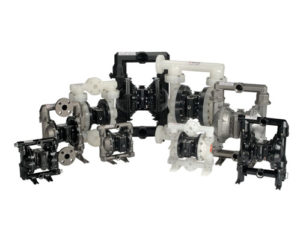
In the manufacturing industry, it is common to store flammable and hazardous chemicals, such as acetone and isopropyl alcohol, in large drums of 55 gallons or more. These chemicals are then dispensed into smaller containers or used directly in the production process. Since these chemicals and their formulations can be flammable, hazardous, or potentially combustible, directors responsible for environmental health and safety are tasked with selecting the most suitable pump for safely handling these liquids, thus ensuring the well-being of their workers.
To guarantee the secure transportation of chemicals, it is essential to employ a sealed or closed-loop pump system that effectively prevents the release of vapours. This ensures that the chemicals remain contained and do not come into contact with the individual responsible for dispensing them.
Manufacturers face significant risks when it comes to the handling of pumps and their contents. Using the incorrect type of pump or, even worse, employees mishandling and spilling materials can have disastrous consequences. If toxic or highly flammable substances are accidentally released, it is inevitable that there will be a considerable increase in worker injuries, devastating fires, and potentially explosive situations. Double diaphragm pumps are used for transferring highly flammable liquids.
Understanding the Safety Data Sheets
Whenever potentially dangerous substances are introduced to a facility, it is essential that they are accompanied by safety data sheets (SDS) and labels that comply with the Globally Harmonised System (GHS). The United Nations developed the GHS in order to establish a standardised method for identifying and conveying information regarding hazardous chemicals.
The Safety Data Sheet (SDS) provides comprehensive information regarding potential environmental risks, appropriate actions to take in the case of minor or major spills, and recommendations for treating injuries resulting from inhalation or direct contact with chemicals. Moreover, SDS also specifies the personal protective equipment (PPE) necessary and offers guidelines for safe storage practices.
When it comes to flammable and combustible liquids, individuals with knowledge in this area may find the content of Safety Data Sheets (SDS) to be disconcerting. These documents, Depending on the specific chemical, may contain details about severe injuries, harm to cells and organs at a genetic level, and even the alarming potential for fatalities in a work environment.
The Safety Data Sheet (SDS) for acetone, a commonly utilised solvent, provides information about its high flammability and the characteristic of burning with bright yellow flames. Additionally, it states that vapours of acetone can travel along surfaces to ignite distant sources of ignition and can be ignited even by minimal static discharge.
Given the significant potential risks involved, guidelines for storage and handling are provided to minimise the occurrence of hazardous incidents. The recommendations for handling flammable and combustible liquids remain consistent and steadfast in the majority, if not all, of the Safety Data Sheets (SDS).
This advice includes:
- Take precautions to prevent inhaling fumes or vapours.
- It is advisable to maintain a safe distance from heat sources, sparks, open flames, or hot surfaces to prevent the risk of ignition.
- Ensure that containers are securely sealed at all times.
- Incorporate grounding or bonding mechanisms to connect the container and receiving equipment.
- Utilise electrical, ventilating, or lighting equipment that is specifically designed to be resistant to explosions in order to prevent the occurrence of potential ignition sources.
- To minimise the risk of static discharge (which can potentially cause a fire or explosion), it is advisable to implement precautionary measures.
Moreover, it is worth noting that a significant number of states and local government bodies in the United States have implemented the NFPA 30 Flammable and Combustible Liquids Code as well as OSHA 29 CFR 1910.106. These codes, aimed at fire safety, cover various aspects, such as the proper handling, storage, and utilisation of flammable liquids. This demonstrates the widespread acceptance and recognition of the importance of adhering to these regulations.
Indeed, this represents just a portion of the remedy. To guarantee the secure transportation of chemicals, it is crucial to undergo appropriate safety education, utilise personal protective gear (PPE), and in certain situations, incorporate additional engineering measures.
Although the Safety Data Sheet (SDS) does not explicitly mention it, the majority, if not all, of these stipulations emphasise the necessity of utilising a specialised pump to transfer flammable or combustible chemicals into smaller containers or at the designated point of use, ensuring the safety of the workplace.
Transfer Equipment Requirements
When it comes to handling chemicals, whether it is a requirement or a recommendation, it is crucial to prioritise safety. This can be achieved by using a sealed or closed-loop pump system that effectively prevents the release of vapours and avoids any contact between the chemicals and the person dispensing them. Additionally, these systems should be designed with durable materials and seals that can withstand prolonged exposure to the chemical substances. Incorporating grounding wires is also necessary to prevent any potential static discharge.
Fortunately, these pumps are readily accessible and are employed in various manufacturing and industrial settings that encounter comparable difficulties. The use of A sealed pump dispensing system not only promotes safety by preventing spills but also facilitates spill-free, eco-friendly transfers, effectively preventing the release of vapours from the container.
When dealing with combustible and flammable liquids, it is crucial to remove any potential sources of ignition, such as flames, hot surfaces, static electricity, or sparks caused by electrical or mechanical activities. This is especially important for highly volatile solvents, as the vapours released (known as VOCs) can travel several feet and ignite if they come into contact with an ignition source.
When moving flammable liquids from larger containers with a capacity of more than 10 litres to smaller containers, it is essential to consider the potential generation of static electricity due to the liquid flow. This static electricity can potentially lead to the creation of sparks, whether the liquid is being poured manually or through the use of a pump. Proper precautions should be taken, particularly when both the bulk container and the receiving vessel are made of metal. To mitigate the risk, it is crucial to securely connect the two containers and the ground with a metal bonding strap or wire. This bonding process facilitates the safe dissipation of static charge to the ground.
For this reason, it is necessary to ground or bond containers when transferring Class 1 liquids (which are considered flammable with a flash point below 100°F) and Class 2 and 3 liquids (which are considered combustible with a flashpoint above 100°F) in order to prevent the risk of electrostatic discharge, which could potentially cause ignition. NFPA 30 Section 18.4.2.2 also mandates the implementation of measures to prevent static electricity during transfer and dispensing procedures.
Pump Selection Guidelines
When it comes to choosing the right pump for different chemicals or formulations in manufacturing, having access to a Chemical compatibility database and guidance can greatly simplify the process and ensure workplace safety.
When dealing with different chemicals and specific formulations, it is crucial to accurately determine the appropriate pump for every application. This decision is often dependent on the choice of materials utilised in constructing the pump, specifically those that will come into contact with the chemicals. Since each chemical possesses distinct characteristics, it is vital to select the suitable gasket, housing, and hoses not only to ensure safety but also to guarantee the longevity of the equipment. Furthermore, it is important to note that flammable liquids necessitate a pump that can be grounded, while food grade liquids require a pump that meets the necessary food-grade standards.
Manufacturers seeking a suitable match can reach out to the supplier of pumps. Reputable pump manufacturers maintain comprehensive databases that provide in-depth information on chemical compatibility, including the appropriate pump type, gasket, hoses, and the necessity of grounding the chemical.
When a chemical compound is present in the database, the pump typically includes a one-year guarantee as either its performance has been tested or its compatibility has been verified by the chemical manufacturer. In cases where the chemical is not listed, the pump manufacturer will assess the Safety Data Sheet (SDS) and, if required, carry out necessary tests to identify the appropriate pump for the specific application.
Assessing the Compatibility of Chemicals
Conducting tests to assess gasket performance involves a straightforward process of immersing standard gaskets in the chemical solution for a period of 5 to 7 days. It should be noted that the volatile nature of vapours often renders them more hazardous than the liquid itself. Vapour tests are carried out when necessary, where the elastomer gasket options, namely Viton, EPDM, Nitrile, and Santoprene, are suspended above the liquid. Subsequently, pumps are assembled and tested using each elastomer. In cases where none of the gaskets prove suitable for the application, Teflon and Kalrez gaskets are employed as alternatives.
The plastic pump housing may require testing when dealing with certain complex aromatics, aliphatics, and flammable liquids. This test involves soaking the components in the chemicals for a period of 60 days to assess if any swelling or binding occurs, as these issues can lead to pump failure.
Manufacturers need to recognise the significant risks associated with the transport of flammable and combustible liquids. Adhering to the guidelines provided by organisations such as NFPA, OSHA, and other regulatory bodies is crucial in order to prevent accidents detailed in the SDS. The consequences of not taking the necessary precautions can include physical harm, long-term respiratory problems, and even loss of life.
Thankfully, ensuring the safety of employees can be reasonably uncomplicated by providing comprehensive safety instruction, utilising personal protective gear (PPE), and employing engineering measures to avert hazardous spills and chemical incidents.





